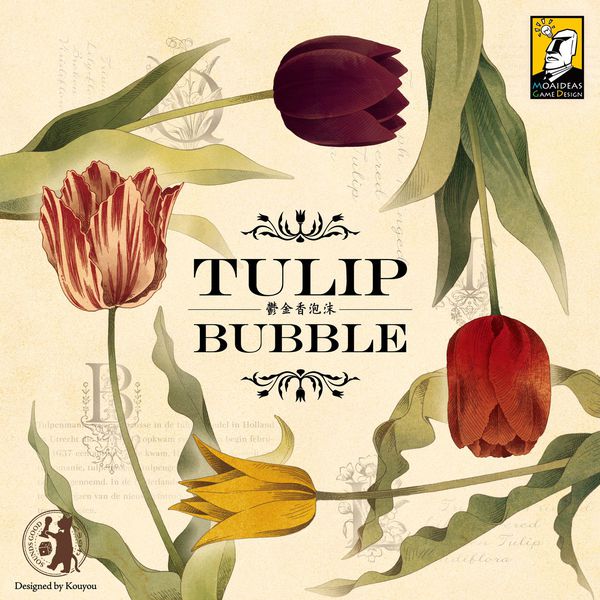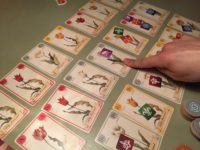- Learning time
- 30 minutes
- First play time
- 90 minutes
Tulip Bubble
Designed by: 紅陽
In 1637 a spectacular market crash occurred in the value of tulips: reckoned to be the first such speculative bubble in the history of finance. If flowers and finance don’t get you salivating though, don’t click away just yet: Tulip Bubble comes replete with strategy, tactics, and not-inconsiderable luck-pushing…
Over an uncertain amount of rounds (the game can end with a bang) players bid up to three times on tulip cards that are laid out in the New Arrivals and Just Sold areas of a market. The flowers coming in the next round (the Next Shipment) are visible, but not available to buy just yet. The prices are dictated by a market board, and if you are the sole bidder: congratulations! You may buy at current market price. If there are several bidders, the bidding starts at the current market value plus one, and the defeated bidders get a kind of compensation payment form the bank based on how high the bidding goes.
Why are you buying tulips? In order to sell them again – as botanically-driven capitalists, at hopefully-extortionate prices.
At the end of each round the value of the three tulip types (red, white, yellow) may change based on what’s left in the market and the Next Shipment: lots of the same colour means the flowers in question will lose value. If there’s very little of a colour, they’ll obviously increase in value instead. The crux of the game is grabbing flowers that will enrich you, then, but as well as the mostly-predictable market fluctuations mentioned above, every round starts with an unpredictable event card that can have beneficial (or catastrophic!) impact on the flowers you hold in your hand. After the market prices are adjusted, everyone has an opportunity to sell: either back to the market, or to a more rewarding collector. Whereas the market accepts anything, collectors are after particular types of flowers (this is where the tulip cards’ otherwise inconsequential A, B and C categories come into play) and the fussier they are, the higher prices they will pay.
There are other wrinkles giving Tulip Bubble extra depth: you can offset a shortage of cash by getting the bank to pay for a flower, but doing so limits how many flowers you’re allowed to bid on. And there is the unexpected endings: if any player makes themselves rich enough, they can buy the one-off Queen of the Night tulip and claim and instant win. Failing that, lurking somewhere at the bottom of the event card deck is the Bubble Burst card – when this is drawn the game also ends instantly: but flowers in your possession are now utterly worthless!
Joe says
I do like an auction game, and this one has some very clever things going on. And it's so, so pretty - though likely to appeal more to stock traders than gardeners. It's pretty swingy, if I recall from my one play - the events deck can really mess with your plans. Would very much like to play again.
The guru's verdict
-
Take That!
Take That!
Players can force bids up just to make opponents spend more (warning: this can backfire!) and there'll no doubt be bidding wars over tulips that a collector wants. You can also be poised to sell to a collector and find to your horror that someone gets there before you - turn order is important in this game! But the most Take That-y element comes from the game itself in the form of the event cards: will your tulips shoot up in value, or crash like wilted petrol-station bouquets?
-
Fidget Factor!
Fidget Factor!
Moderate. Though a first play will be long, familiarity speeds things up considerably. That said, there are decisions to mull over, and they will be mulled.
-
Brain Burn!
Brain Burn!
The rules are actually more of a two-star complexity, but the moving parts of the game and various factors to consider (including what event cards have already been seen and the likelihood of the next one being one you want/don't want AND the potential for negotiation between players as to what they bid on) mean it probably skews towards older children and adults.
-
Again Again!
Again Again!
You never know what flowers will come along next (or to be exact, the round after next) and more pertinently, which event card will flip to make/ruin your day (delete as appropriate)!
















Sam says
Gosh, what feisty game lies hidden in this pretty little box. Probably not for the younger members of the household, as although the rules are not the most complicated, they are a little more opaque than the likes of Catan or Ticket to Ride. But for older players what emerges from the play is a battle of sorts, as you navigate your way through the surprisingly perilous landscape of tulip wheeler-dealing. There's plenty of luck too - possibly too much luck for some (stock manipulation in Hab & Gut is less chaotic) but for us part of the fun is the potential for spectacular wins and fails - someone in last place can pull off an amazing victory with good timing and a little (or big) bit of fortune in an unexpected final act. Oh, and the artwork is just lovely.